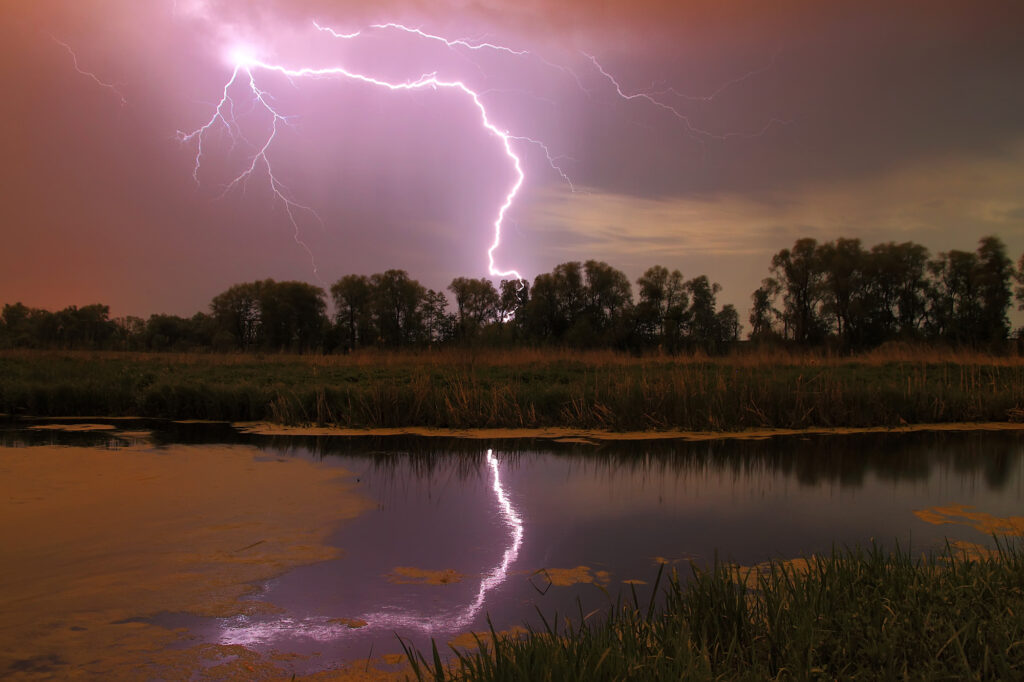
When Mother Nature unleashes her fury on our environment, a certain amount of cleanup always seems to follow. In terms of pond maintenance, there are several steps that you might want to take after a storm to ensure the quality of your water, including the following:
- Treat The Water With Beneficial Bacteria
A significant rain event can upset the balance in your pond, adding more water, and often, this water is runoff from your lawn or farm, which may contain pesticides and/or herbicides. This can alter the oxygen levels in your pond and cause the rapid accumulation of floating green organic matter.
A large rain event also can cause temperatures in your pond to fluctuate and possibly spike. When temperatures spike, this causes oxygen levels in your pond to drop, which also promotes the growth of floating green organic matter. Treating the water with beneficial bacteria for ponds can mitigate this problem.
At Healthy Ponds, we have several all-natural beneficial bacteria products and Natural BLAST® can be an excellent option to consider using after a large rain event or when temperatures spike. The beneficial bacteria in Natural BLAST® consume excess nutrients in your water and break down organic matter that often results from increased water temperature or a large rain event.
Natural BLAST® is not only an effective pond maintenance treatment, it is also easy to use. You simply toss the water-soluble bags into your pond evenly throughout the water, near aeration if possible. The bags immediately begin releasing the beneficial bacteria, and you can repeat the treatment every 7-10 days if needed.
- Remove Debris
Once the storm has passed and it’s safe to be outside, head down to your pond and remove as much debris as possible, especially items such as leaves and tree branches. Leaves will sink to the bottom of the pond and add to the sludge layer, which lowers oxygen levels in your pond. A heavy sludge layer and lower oxygen levels can contribute to the rapid accumulation of floating green organic matter.
- Check Your Equipment
If you have a filtration system or aeration system (or both), ensure that these pieces of equipment have not been damaged by the storm. We always recommend that pond owners have aeration systems in place to help circulate the water, which keeps the temperatures down and prevents water from becoming stagnant. Circulating the water also helps to better distribute beneficial bacteria throughout your pond ecosystem.
4 Preventative Measures
While it’s important to handle pond clean-up quickly after a storm, preventative pond maintenance can make it less likely for a storm to damage your pond. Here are a few steps you can take to prevent minimize damage from storms.
- Add Netting Or A Pond Cover
You can cut down on pond maintenance after storms or when autumn leaves are falling by placing a cover or netting over your pond. This can be a good option for small ponds, such as a decorative pond or a koi pond, and it can make pond maintenance much easier and prevent leaves and other debris from settling into your pond water.
- Trim Back Trees
Pruning your trees can prevent branches and twigs from blowing into your pond during severe weather. Pruning ensures that the weight of the tree is distributed properly, which prevents branches from snapping off, either in a storm or just because the weight of the branch is too great for the tree to support.
Unless you are experienced with tree pruning, it is often best to leave this task to a professional. Annual pruning in late fall or early winter, can improve the health of your trees and also might ensure that tree debris doesn’t end up in your pond.
- Prevent Runoff
Runoff from your farm or your lawn can reduce the quality of your pond water by introducing excessive amounts of nutrients such as nitrogen and phosphorus. One option to consider would be switching to a zero-nitrogen fertilizer or a low-nitrogen fertilizer to prevent excess nitrogen from ending up in your pond.
Another tactic would be to plant a barrier of beneficial plants around the shore of your pond to help prevent runoff from entering the water. Ensuring a healthy lawn also can be a good idea as a healthy lawn can soak up more rainwater, so it won’t run into your pond.
- Treat Monthly With Beneficial Bacteria
Monthly beneficial bacteria treatments can remove excess nutrients in your pond, and our AquaSpherePRO® is all-natural and easy-to-use. You simply toss enough spheres to accommodate the number of gallons of water in your pond and these spheres immediately begin releasing beneficial bacteria. These bacteria consume excess nutrients in your pond, and each sphere works for 30 days.
Natural BLAST® should be used in conjunction with AquaSpherePRO®. You cannot overtreat water with beneficial bacteria, but you can under-treat, which is why we recommend using both products at the same time. Our all-natural products, such as AquaSpherePRO® and Natural BLAST® contain no chemicals and are veterinarian-approved and safe for fish, wildlife, pets and people.
If you aren’t quite sure which pond maintenance products to use, contact the experts at Healthy Ponds at any time and we will provide you with a solution for your pond problem. We offer free personalized pond treatment plans at https://healthyponds.com/free-pond-plan/.

